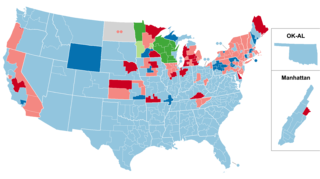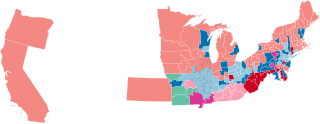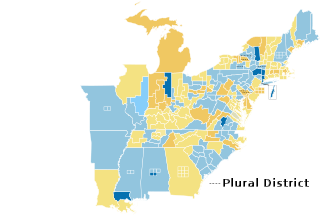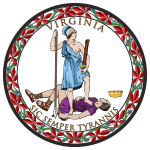
The 1934 United States Senate elections were held in the middle of Democratic President Franklin D. Roosevelt's first term. The 32 seats of Class 1 were contested in regular elections, and special elections were held to fill vacancies. During the Great Depression, voters strongly backed Roosevelt's New Deal and his allies in the Senate, with Democrats picking up a net of nine seats, giving them a supermajority. This marked the first time that an incumbent president's party gained seats in both houses of Congress in a midterm election, followed by 1998 and 2002. This was also the second of three times in American history that the opposition party failed to flip any Senate seats, alongside 1914 and 2022.

The 1934 United States House of Representatives elections were elections for the United States House of Representatives to elect members to serve in the 74th United States Congress. They were held for the most part on November 6, 1934, while Maine held theirs on September 10. They occurred in the middle of President Franklin D. Roosevelt's first term. The Democratic Party continued its progress, gaining another 9 net seats from the opposition Republican Party, who also lost seats to the Progressive Party. The Republicans were reduced below one-fourth of the chamber for the first time since the creation of the party. The Wisconsin Progressive Party, a liberal group which allied with the Democrats, also became a force in Wisconsin politics.

The 1862–63 United States House of Representatives elections were held on various dates in various states between June 2, 1862, and November 3, 1863, during the American Civil War and President Abraham Lincoln's first term. Each state set its own date for its elections to the House of Representatives before the first session of the 38th United States Congress convened on December 7, 1863. The congressional reapportionment based on the 1860 United States Census was performed assuming the seceded states were still in the union, increasing the number of congressional districts to 241. West Virginia was given three seats from Virginia after the former broke away from the latter to rejoin the union as a separate state. The seceded states remained unrepresented and left 58 vacancies. Republicans lost 22 seats and the majority, while Democrats gained 28.

The 1860–61 United States House of Representatives elections were held on various dates in various states between August 6, 1860 and October 24, 1861, before or after the first session of the 37th United States Congress convened on July 4, 1861. The number of House seats initially increased to 239 when California was apportioned an extra one, but these elections were affected by the outbreak of the American Civil War and resulted in over 56 vacancies.

The 1840–41 United States House of Representatives elections were held on various dates in various states between July 6, 1840 and November 2, 1841. Each state set its own date for its elections to the House of Representatives, before or after the first session of the 27th United States Congress convened on May 31, 1841. Elections were held for all 242 seats, representing 26 states.
The 1820–21 United States House of Representatives elections were held on various dates in various states between July 3, 1820 and August 10, 1821. Each state set its own date for its elections to the House of Representatives before the first session of the 17th United States Congress convened on December 3, 1821. They coincided with President James Monroe winning reelection unopposed.

The 1812–13 United States House of Representatives elections were held on various dates in various states between August 3, 1812 and April 30, 1813. Each state set its own date for its elections to the House of Representatives before the first session of the 13th United States Congress convened on May 24, 1813. They coincided with James Madison being re-elected president.

Robert Lincoln Ramsay was an English-born American politician who served as a member of the United States House of Representatives for West Virginia's 1st congressional district from 1933 to 1939, 1941 to 1943, and 1949 to 1953.

The 1980 United States House of Representatives elections in Virginia were held on November 4, 1980 to determine who will represent the Commonwealth of Virginia in the United States House of Representatives. Virginia had ten seats in the House, apportioned according to the 1970 United States Census. Representatives are elected for two-year terms.

The 1990 United States House of Representatives elections in Virginia were held on November 6, 1990 to determine who will represent the Commonwealth of Virginia in the United States House of Representatives. Virginia had ten seats in the House, apportioned according to the 1980 United States Census. Representatives are elected for two-year terms.

The 1932 United States House of Representatives elections in Virginia were held on November 8, 1932, to determine who will represent the Commonwealth of Virginia in the United States House of Representatives. Representatives are elected for two-year terms. Virginia had only nine seats in the House, losing a seat due to re-apportionment following the 1930 United States census. This election was unique because all representatives were elected at-large instead of the previously used electoral district system. However, this idea was not popular and the state returned to using electoral districts in the next election.

The 2004 United States House of Representatives elections in Virginia were held on November 2, 2004 to determine who will represent the Commonwealth of Virginia in the United States House of Representatives. Virginia has eleven seats in the House, apportioned according to the 2000 United States Census. Representatives are elected for two-year terms.

The 1984 United States House of Representatives elections in Virginia were held on November 6, 1984 to determine who will represent the Commonwealth of Virginia in the United States House of Representatives. Virginia had ten seats in the House, apportioned according to the 1980 United States Census. Representatives are elected for two-year terms.

The 1962 United States House of Representatives elections in Virginia were held on November 6, 1962 to determine who will represent the Commonwealth of Virginia in the United States House of Representatives. Virginia had ten seats in the House, apportioned according to the 1960 United States Census. Representatives are elected for two-year terms.

The 1956 United States House of Representatives elections in Virginia were held on November 6, 1956 to determine who will represent the Commonwealth of Virginia in the United States House of Representatives. Virginia had ten seats in the House, apportioned according to the 1950 United States Census. Representatives are elected for two-year terms.

The 1934 United States Senate election in Virginia was held on November 6, 1934. Incumbent Senator Harry F. Byrd, Sr. was re-elected to his first full term after defeating Republican Lawrence C. Page in a landslide.

The 1940 United States House of Representatives elections in Virginia were held on November 5, 1940 to determine who will represent the Commonwealth of Virginia in the United States House of Representatives. Virginia had nine seats in the House, apportioned according to the 1930 United States Census. Representatives are elected for two-year terms.

The 1928 United States House of Representatives elections in Virginia were held on November 6, 1928 to determine who will represent the Commonwealth of Virginia in the United States House of Representatives. Virginia had ten seats in the House, apportioned according to the 1920 United States Census. Representatives are elected for two-year terms.

The 1934 United States Senate election in Delaware took place on November 6, 1934. Incumbent Republican U.S. Senator John G. Townsend Jr. was re-elected to a second term in office over Democratic U.S. Representative Wilbur L. Adams.









